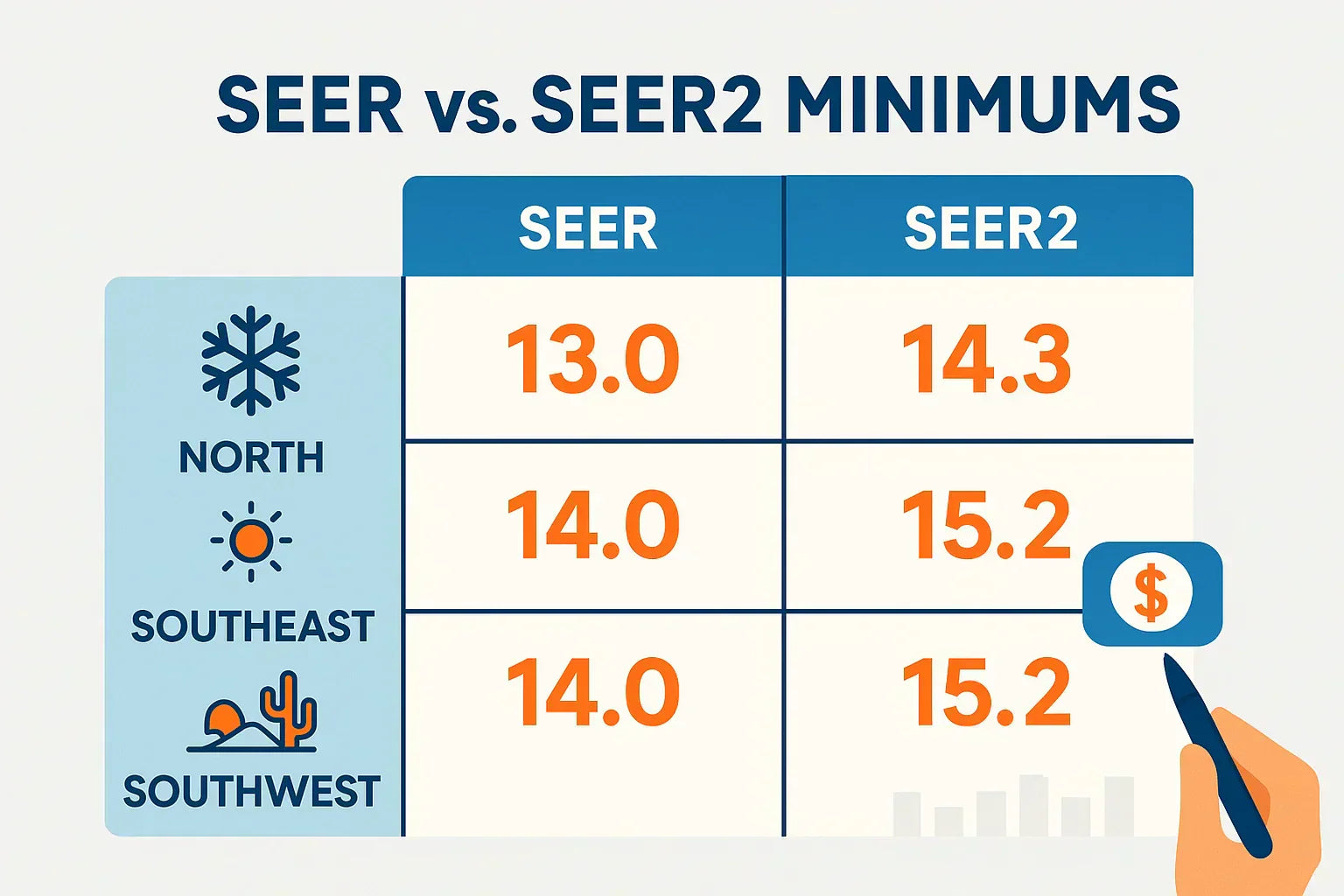By Alex Lane | Your Home Comfort Advocate
If you’re planning to replace your air conditioner or heat pump in 2025, you’ll need to know more than just the brand and price. One of the most important — and legally required — specs is whether the system meets the minimum SEER2 rating for your region.
These ratings aren’t just efficiency targets — they’re federal standards. Install a system that doesn’t meet your region’s requirement, and you could run into serious issues: code violations, denied rebates, or even forced equipment replacement.
Let’s break down what SEER2 minimums are by region, why they matter, and how to make sure your next HVAC system is both compliant and cost-effective.
🧰 What is SEER2 and Why Does It Matter?
SEER2 stands for Seasonal Energy Efficiency Ratio 2, the updated U.S. Department of Energy (DOE) standard for measuring cooling efficiency. It replaced the older SEER system in 2023 and uses tougher test conditions to simulate real-world performance.
If you’re not familiar with how SEER2 works, start with this quick breakdown:
👉 What is SEER2 and Why It Matters
🌎 Why Regional SEER2 Standards Exist
The U.S. is divided into three climate-based efficiency regions — North, South, and Southwest — because HVAC systems work harder in hotter climates. That’s why efficiency standards are higher in southern states where air conditioners run for more months of the year.
These regional standards ensure that systems are:
-
Right-sized for the local cooling load
-
Tested for realistic usage patterns
-
Aligned with federal energy-saving goals
📌 Important: SEER2 minimums aren’t optional. If you install a system below the required rating, it may be illegal, void rebate eligibility, or prevent final inspection approval.
🗺️ SEER2 Regional Map & 2025 Minimums
Here’s a quick breakdown of the 2025 minimum SEER2 ratings for each DOE region:
🔵 North Region
-
Includes: Northern and some central states (e.g., NY, IL, OH, WA)
-
Minimum SEER2:
-
All AC systems: 13.4 SEER2
-
🟡 South Region
-
Includes: Southeastern and Gulf states (e.g., TX, FL, GA, NC)
-
Minimum SEER2:
-
<45,000 BTU/hr: 14.3 SEER2
-
≥45,000 BTU/hr: 13.8 SEER2
-
🔴 Southwest Region
-
Includes: CA, AZ, NV, NM
-
Minimum SEER2:
-
<45,000 BTU/hr: 14.3 SEER2
-
≥45,000 BTU/hr: 13.8 SEER2
-
Bonus: EER2 requirements also apply due to dry climate conditions
-
See full map and updates at SEER2.com
📊 Why SEER2 Numbers Look “Lower” Than SEER
If you’re used to seeing 14 or 16 SEER systems, you might wonder why SEER2 numbers seem lower. That’s because SEER2 uses higher static pressure in tests, which reflects how systems behave with real ductwork, filters, and airflow restrictions.
🧮 Quick SEER-to-SEER2 Conversion:
SEER2 ≈ SEER × 0.95
So a 16 SEER system from 2022 would now rate around 15.2 SEER2.
📝 State-by-State SEER2 Minimums (Highlights)
| State | Region | Min SEER2 (<45k BTU/hr) | Min SEER2 (≥45k BTU/hr) |
|---|---|---|---|
| California | Southwest | 14.3 | 13.8 |
| Texas | South | 14.3 | 13.8 |
| New York | North | 13.4 | 13.4 |
| Florida | South | 14.3 | 13.8 |
| Arizona | Southwest | 14.3 | 13.8 |
| Illinois | North | 13.4 | 13.4 |
📌 Always confirm your region with your local building department or contractor. It’s their job to make sure the system they install is compliant — but it’s your investment.
📑 How to Verify SEER2 Compliance
✅ 1. Look at the Yellow EnergyGuide Label
Every new system comes with an EnergyGuide label — the yellow sheet you’ve probably seen stuck on the unit.
-
SEER2 and HSPF2 are listed clearly
-
If it says only “SEER,” the system may not meet 2025 rules
✅ 2. Ask for the AHRI Certificate
The AHRI certificate lists all official test results, including SEER2, EER2, and HSPF2.
Use the AHRI Certified Directory to look up the model number and confirm it matches your region’s requirements.
💸 SEER2 and Rebates in 2025
Minimum SEER2 compliance is often the baseline for rebate eligibility. Here are three things to watch:
-
Federal Tax Credits
The Inflation Reduction Act offers up to $2,000 in credits for high-efficiency systems — but only if they meet SEER2 minimums. -
Utility Rebates
Many local utilities require 15.2 SEER2 or higher for tiered rebates. Some also require EER2 or HSPF2 benchmarks. -
ENERGY STAR Requirements
To qualify as ENERGY STAR certified, a system must exceed the DOE minimum. Check details here:
ENERGY STAR Central AC Criteria
You can also check zip-code-specific rebates here: ENERGY STAR Rebate Finder
💬 Final Thoughts from the Field
If you’re in the market for a new system this year, don’t just look at efficiency — look at compliance. A high-SEER2 system that isn’t matched correctly or doesn’t meet your region’s requirements can cost you in more ways than one.
And remember: going just above the minimum is often worth it. A bump from 14.3 to 16 SEER2 could save hundreds per year — especially in hotter regions.
🔗 What’s Next in the SEER2 Series?
Wondering if going beyond the minimum is actually worth the extra cost?
👉 Does a Higher SEER2 Rating Actually Save You Money?
Alex Lane
Your Home Comfort Advocate







